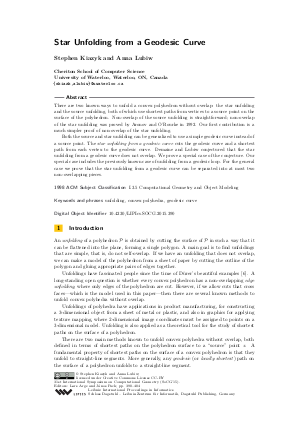Star Unfolding from a Geodesic Curve
Authors Stephen Kiazyk, Anna Lubiw
-
Part of:
Volume:
31st International Symposium on Computational Geometry (SoCG 2015)
Part of: Series: Leibniz International Proceedings in Informatics (LIPIcs)
Part of: Conference: Symposium on Computational Geometry (SoCG) - License:
 Creative Commons Attribution 3.0 Unported license
Creative Commons Attribution 3.0 Unported license
- Publication Date: 2015-06-12
File

PDF
LIPIcs.SOCG.2015.390.pdf
- Filesize: 1.14 MB
- 15 pages
Document Identifiers
Subject Classification
Keywords
- unfolding
- convex polyhedra
- geodesic curve
Metrics
- Access Statistics
-
Total Accesses (updated on a weekly basis)
0PDF Downloads0Metadata Views
Abstract
There are two known ways to unfold a convex polyhedron without overlap: the star unfolding and the source unfolding, both of which use shortest paths from vertices to a source point on the surface of the polyhedron. Non-overlap of the source unfolding is straightforward; non-overlap of the star unfolding was proved by Aronov and O'Rourke in 1992. Our first contribution is a much simpler proof of non-overlap of the star unfolding. Both the source and star unfolding can be generalized to use a simple geodesic curve instead of a source point. The star unfolding from a geodesic curve cuts the geodesic curve and a shortest path from each vertex to the geodesic curve. Demaine and Lubiw conjectured that the star unfolding from a geodesic curve does not overlap. We prove a special case of the conjecture. Our special case includes the previously known case of unfolding from a geodesic loop. For the general case we prove that the star unfolding from a geodesic curve can be separated into at most two non-overlapping pieces.
Cite As Get BibTex
Stephen Kiazyk and Anna Lubiw. Star Unfolding from a Geodesic Curve. In 31st International Symposium on Computational Geometry (SoCG 2015). Leibniz International Proceedings in Informatics (LIPIcs), Volume 34, pp. 390-404, Schloss Dagstuhl – Leibniz-Zentrum für Informatik (2015)
https://doi.org/10.4230/LIPIcs.SOCG.2015.390
BibTex
@InProceedings{kiazyk_et_al:LIPIcs.SOCG.2015.390,
author = {Kiazyk, Stephen and Lubiw, Anna},
title = {{Star Unfolding from a Geodesic Curve}},
booktitle = {31st International Symposium on Computational Geometry (SoCG 2015)},
pages = {390--404},
series = {Leibniz International Proceedings in Informatics (LIPIcs)},
ISBN = {978-3-939897-83-5},
ISSN = {1868-8969},
year = {2015},
volume = {34},
editor = {Arge, Lars and Pach, J\'{a}nos},
publisher = {Schloss Dagstuhl -- Leibniz-Zentrum f{\"u}r Informatik},
address = {Dagstuhl, Germany},
URL = {https://drops.dagstuhl.de/entities/document/10.4230/LIPIcs.SOCG.2015.390},
URN = {urn:nbn:de:0030-drops-51380},
doi = {10.4230/LIPIcs.SOCG.2015.390},
annote = {Keywords: unfolding, convex polyhedra, geodesic curve}
}
Author Details
References
-
Pankaj K. Agarwal, Boris Aronov, and Catherine A. Schevon. Star unfolding of a polytope with applications. SIAM Journal on Computing, 26:1689-1713, 1997.

-
Boris Aronov and Joseph O'Rourke. Nonoverlap of the star unfolding. Discrete & Computational Geometry, 8(3):219-250, 1992.

-
Erik D. Demaine, Martin L. Demaine, Anna Lubiw, Arlo Shallit, and Jonah Shallit. Zipper unfoldings of polyhedral complexes. In Proceedings of the 22nd Annual Canadian Conference on Computational Geometry (CCCG), pages 219-222, August 2010.

-
Erik D. Demaine and Anna Lubiw. A generalization of the source unfolding of convex polyhedra. In Revised Papers from the 14th Spanish Meeting on Computational Geometry (EGC 2011), volume 7579 of Lecture Notes in Computer Science, pages 185-199, Alcalá de Henares, Spain, June 27-30 2012.

-
Erik D. Demaine and Joseph O'Rourke. Geometric Folding Algorithms: Linkages, Origami, Polyhedra. Cambridge University Press, New York, NY, USA, 2007.

-
Albrecht Dürer. The Painter’s Manual: A Manual of Measurement of Lines, Areas, and Solids by Means of Compass and Ruler Assembled by Albrecht Dürer for the Use of All Lovers of Art with Appropriate Illustrations Arranged to be Printed in the Year MDXXV. The literary remains of Albrecht Dürer. Abaris Books, 1977.

-
Kouki Ieiri, Jin-ichi Itoh, and Costin Vîlcu. Quasigeodesics and farthest points on convex surfaces. Advances in Geometry, 11(4):571-584, 2011.

-
Jin-Ichi Itoh, Joseph O'Rourke, and Costin Vîlcu. Source unfoldings of convex polyhedra with respect to certain closed polygonal curves. In Proceedings of the 25th European Workshop on Computational Geometry (EuroCG), pages 61-64, 2009.

-
Jin-ichi Itoh, Joseph O'Rourke, and Costin Vîlcu. Star unfolding convex polyhedra via quasigeodesic loops. Discrete & Computational Geometry, 44(1):35-54, 2010.

-
Stephen Kiazyk. The star unfolding from a geodesic curve. Master’s thesis, Cheriton School of Computer Science, University of Waterloo, 2014.

-
Joseph O'Rourke and Costin Vîlcu. Development of curves on polyhedra via conical existence. Computational Geometry, 47(2, Part A):149-163, 2014.

-
Micha Sharir and Amir Schorr. On shortest paths in polyhedral spaces. SIAM Journal on Computing, 15(1):193-215, 1986.

